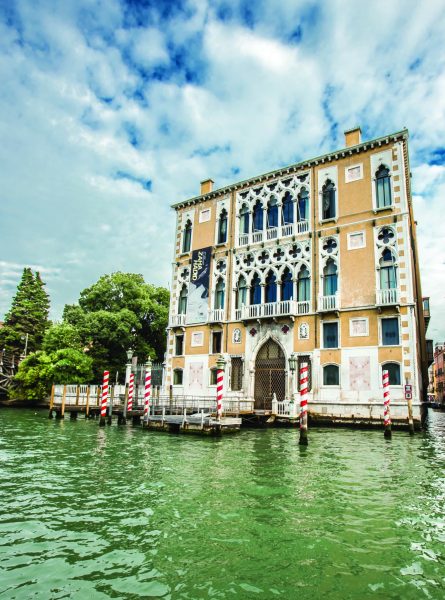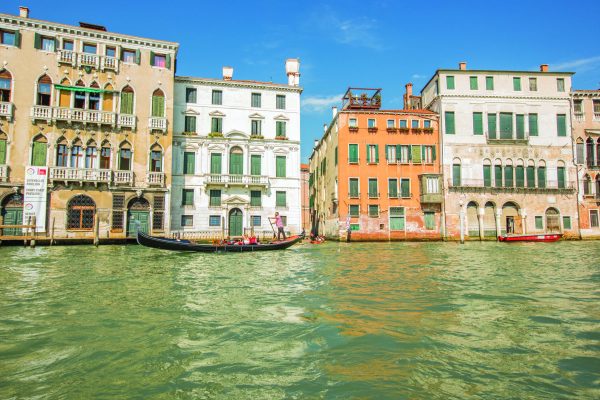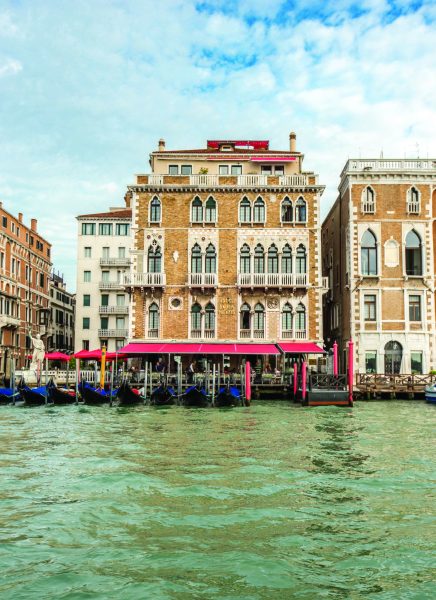The best way to see the wealth of sumptuous palaces in Venice is by water, says Sara Scarpa

Images by Iain Reid
The Grand Canal, Venice’s main artery, is where the most illustrious Venetian noble families lived and where the most prestigious palaces still stand. These palazzi have been the homes of artists, writers, musicians, doges and, of course, merchants. If you take the vaporetto (the water bus) along the Grand Canal you will see a succession of big windows of different shapes, as well as balconies, loggias, arcades, pointed arches, rounded arches, pretty decorations like a row of lace, ornate carvings, red porphyry roundels, lions and diverse chimney pots. There is so much to take in that you will struggle to admire it all in one journey! All along the canal’s banks you can see the grand homes that showed off the wealth and power of the families that lived there.
Unique fusion
The architecture of the palaces springs from different periods: Byzantine, Gothic, Renaissance, Baroque and Neoclassical. The styles of western Europe combined with the Byzantine style create a unique fusion. And by looking at the palaces you will be able to trace the history of the city and get a better understanding of its past. As Venice was protected by water, the palaces are open and elegant. In most cases they still show in their architecture the traces of their beginnings as a casa-fondaco, (a house-warehouse): both the home and the place of trade for its merchant owners.
The houses have two entrances: one much more magnificent, which opens upon the Canal Grande, and the other much more humble, accessed from the land. The big room on the ground floor was not only a grand entrance. It was also – and most importantly – the room that served for the loading and unloading of goods. The piano nobile, in contrast, was originally where the merchandise would be shown to clients and, later on, became the perfect setting for welcoming guests and having parties. Above this was where the servants lived, and even higher was the altana, the wooden platform on the roof where Venetian ladies could bleach their hair in the sun in complete privacy and which is nowadays a place used to dry the laundry and tan in peace!
Fontaco dei Tedeschi
The Fondaco dei Tedeschi (the Warehouse of the Germans) is one of the best examples of a casa-fondaco. Located near the Rialto bridge, this functional building was, as the name suggests, the warehouse – as well as the living quarters and marketplace – for German merchants in Venice. (German merchants were here in numbers and wielded much power in the city.)
At the beginning of the 16th century its façade was frescoed by Giorgione and Titian. (The only surviving fragments are now housed at the Ca’ d’Oro.) In the 17th century the palace was converted into a customs house, and in the 19th century into a post office, where my gran – as she always reminded me when we passed by – used to work. Now it has been converted into a department store, having been completely restored by the Dutch architecture firm OMA.

Ca’ da Mosto
This 13th-century palace is one of the oldest on the Grand Canal and another great example of a casa-fondaco. Here, Alvide Ca’ Da Mosto, the explorer who discovered the Cape Verde Islands, was born in 1432. He is an ancestor of Francesco Da Mosto, who you probably know for BBC TV documentary series Francesco’s Venice.
Ca’ D’oro
Almost in front of Rialto fish market, another palace stands out for its particular elegance: Ca’ d’Oro. Ca’ is the Venetian shortening of casa (house) and oro, of course, means gold – the façade of the palace was indeed gilded.
Built by Mariano Contarini in the early 15th century, the palace survived almost intact for four centuries until the time the dancer Marie Taglioni was given it as a present by her Russian-prince lover. The marble decoration was stripped away and the medieval outdoor staircase was removed. Luckily, when the financier Baron Franchetti acquired the palace he restored it to its original appearance. Here today you will find an interesting museum based mainly on Franchetti’s rich art collection – stunning paintings (among which are works by Mantegna and Carpaccio), bronze statues, marble sculptures, furniture, medals and the aforementioned fragments of frescoes by Titian and Giorgione. There is also a pretty inner courtyard, incredible mosaic floors and a great view over Rialto from its loggia.

The Doges’ Palace
There are many other wonderful palaces in Venice we could talk about, but obviously, the most magnificent – and the very symbol of La Serenissima – is the world-famous Doges’ Palace. In 810, when the seat of government was moved from Malamocco to Rivoalto (which is today known as Rialto), it was decided that they would build the Doges’ Palace.
No traces remain of that original 9th-century building, but the new palace housed public offices, courtrooms, prisons, the Doges’ apartments, an armoury, stables and other facilities; and until the fall of the Venetian Republic it was the heart of the city’s political power.
The famous Sala del Maggior Consiglio (Hall of the Great Council) is the most impressive for its sheer size – and for the splendour of the decorations of its ceiling and walls by Veronese, Bassano, Palma il Giovane and Tintoretto. Tintoretto’s Paradise (which was finished by his son Domenico) holds the record as the biggest oil painting in the world. Also by Tintoretto are the portraits on the walls of seventy-six Doges, one of which is conspicuously covered by a painted black cloth. This is the portrait of Marino Faliero, the Doge accused of high treason who was beheaded by the Republic.
So, the next time you are in Venice, be sure to take a trip on the vaporetto (boat number 1) from Lido to Santa Lucia railway station. Go early in the morning so you can grab a seat outside at the front of the boat, a grandstand seat from where you can fully enjoy the view of these historic treasures on the Grand Canal.
